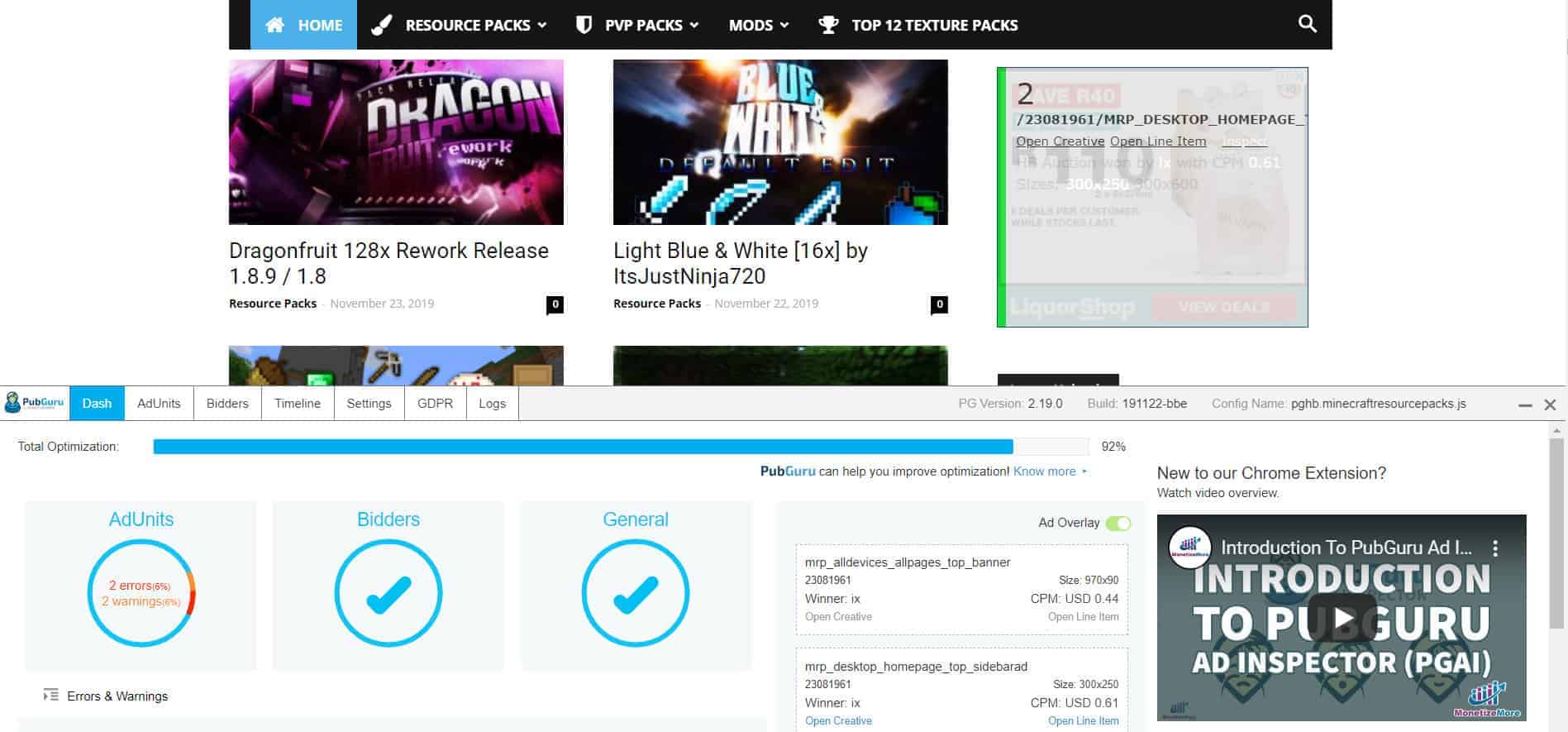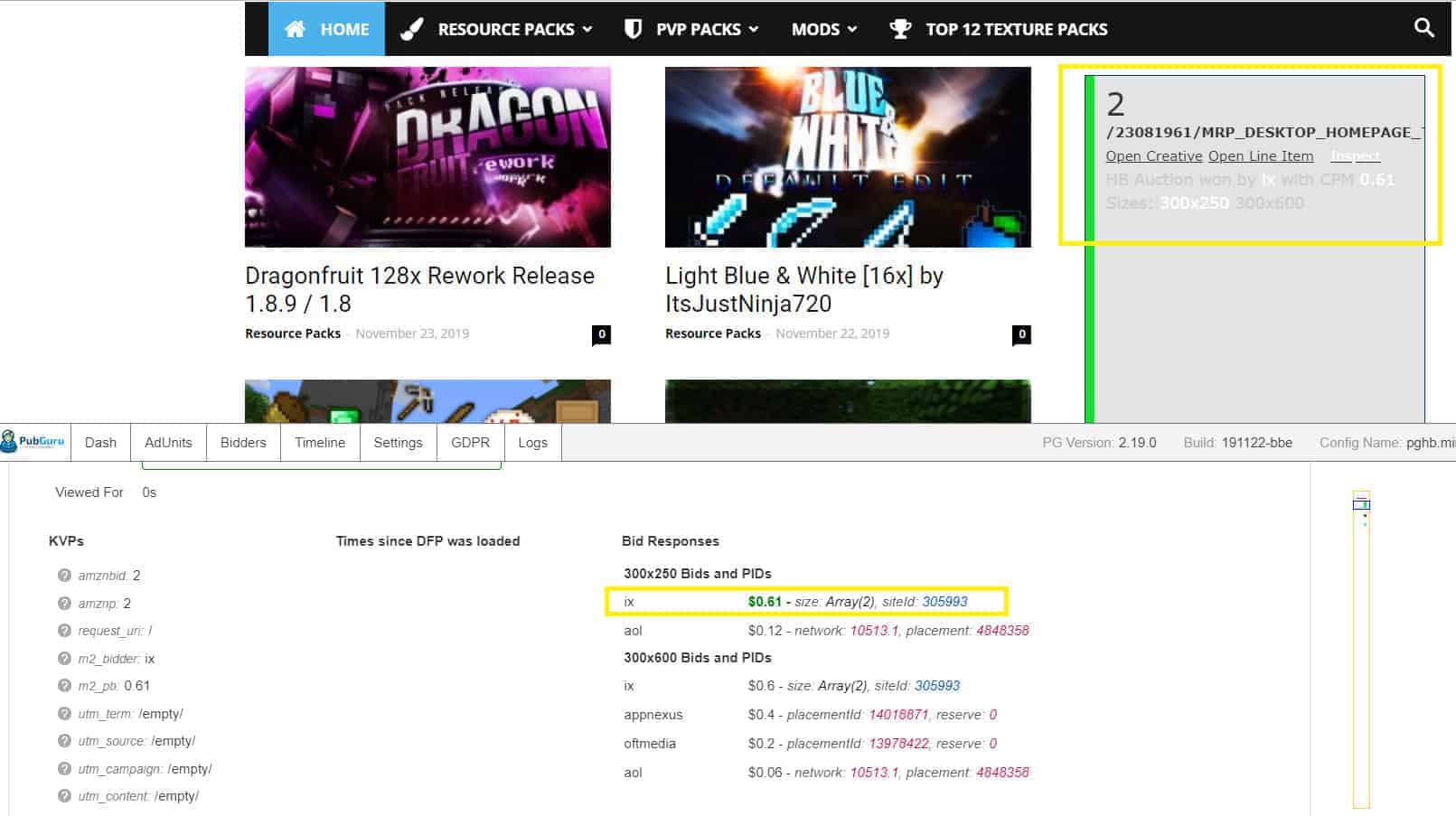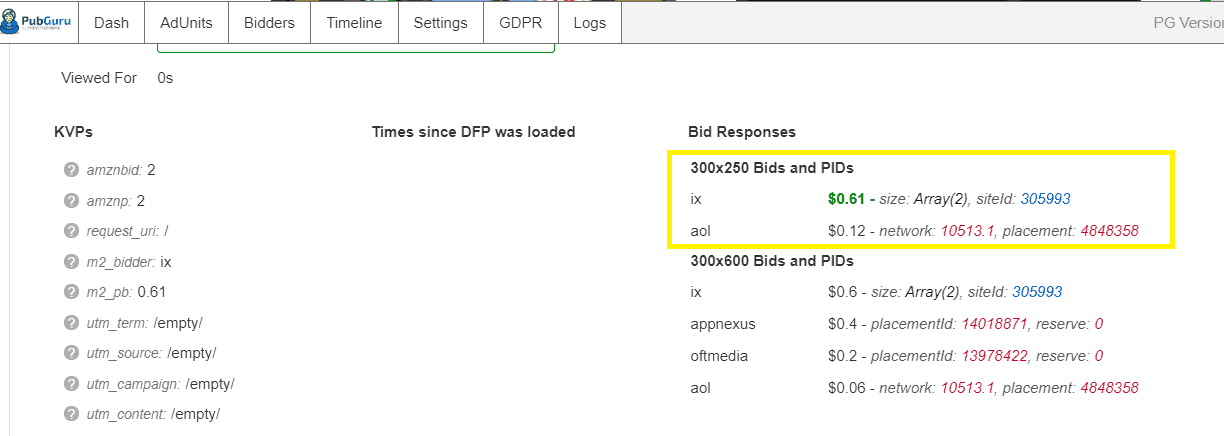Ever wanted to find the winning bid for a specific ad unit? How on earth would you go about determining that? How about discovering which ad networks were bidding on an ad unit and what their bids were?
Your first thought might be: “I’m going to need some serious technical skills and a lot of time to figure this one out.” Think again! In this post, I’d like to show you how you can do all that and much more in mere seconds with PubGuru Ad Inspector!
Don’t know what PubGuru Ad Inspector is? It’s a free Chrome extension developed by MonetizeMore crammed full of features to make the life of any publisher super simple! It allows publishers to analyze ad setups for any website and gain insight into ad units, bidders, GDPR, technical logs, and much more.
Be sure to find out more about all the smart features included in PubGuru Ad Inspector here: https://www.monetizemore.com/blog/how-use-smart-notifications-troubleshoot-and-optimize-programmatic-ads/.
For now, let me show you how to get a handle on your bidders without breaking a sweat.
What is Real Time Bidding (RTB)?
Real-time bidding (RTB) is a method of buying and selling online advertising impressions through a real-time auction. Advertisers use RTB to buy ad impressions on a per-impression basis rather than buying ad space in bulk. In real-time bidding, ad impressions are auctioned off in real-time, and advertisers bid on them based on their targeting parameters and the value they place on each impression.
The Evolution of Online Advertising
Before we dive deeper into RTB, let’s take a quick look at how online advertising has evolved over the years. In the early days of online advertising, advertisers would typically buy ad space in bulk from a publisher or ad network. They would pay a fixed price per ad unit, regardless of whether or not the ad was actually viewed by a user. This model is often referred to as “direct buying.”
Over time, advertisers began to look for more efficient ways of buying ad space. They wanted to ensure that their ads were reaching the right audience and that they were only paying for ad impressions that were actually viewed by users. This led to the development of various ad targeting technologies, such as demographic targeting and contextual targeting.
As ad targeting technology evolved, so did the way advertisers purchased ad space. The rise of programmatic advertising allowed advertisers to automate the process of buying and selling ad impressions. Programmatic advertising refers to the use of software to buy and sell advertising space. This process allowed advertisers to target their ads to specific audiences more effectively, and it also made the buying and selling process more efficient.
How RTB Differs from Traditional Advertising Methods
Real-time bidding differs from traditional advertising methods in several key ways. In traditional advertising, advertisers often negotiate fixed rates with publishers or ad networks. They will typically buy ad space in bulk, with little or no targeting capabilities. In contrast, RTB allows advertisers to bid on each ad impression individually, using sophisticated targeting techniques to ensure that their ads are reaching the right audience.
With RTB, ad impressions are auctioned off in real-time. Advertisers can bid on each impression based on various criteria, such as the user’s location, device type, or browsing history. This allows advertisers to target their ads more effectively and only pay for ad impressions that are likely to result in conversions or other desired actions.
Real-time bidding has revolutionized the online advertising industry, providing advertisers with a more efficient and effective way to reach their target audience. With the ability to bid on each ad impression individually, advertisers can ensure that they are only paying for ad space that is likely to result in a conversion or other desired action. This has led to increased efficiency and effectiveness in online advertising campaigns, as well as increased revenue for publishers and ad networks.
Another benefit of RTB is that it allows for real-time optimization of ad campaigns. Publishers can use data from the auction process to adjust their bidding strategies and targeting parameters in real-time, ensuring that their ads are reaching the right audience at the right time. This can lead to higher conversion rates and a better return on investment for advertisers.
Overall, real-time bidding is a powerful tool for advertisers and publishers alike. It allows for more efficient and effective programmatic advertising campaigns, while also providing publishers and ad networks with a new revenue stream. As technology continues to evolve, it will be interesting to see how RTB continues to shape the online advertising industry.
The RTB Ecosystem
The real-time bidding (RTB) ecosystem is a complex network of platforms and technologies that enable advertisers to purchase ad inventory in real-time bidding auctions. The ecosystem includes demand-side platforms (DSPs), supply-side platforms (SSPs), ad exchanges, and data management platforms (DMPs).
Demand-Side Platforms (DSPs)
Demand-side platforms (DSPs) are essential components of the RTB ecosystem. DSPs provide advertisers with a single interface to manage their advertising campaigns across multiple channels, including display, video, mobile, and social media. DSPs use sophisticated algorithms to optimize ad campaign performance and ensure that ad impressions are purchased at the optimal price.
One of the key advantages of using a DSP is the ability to target specific audiences. DSPs allow advertisers to target their ads based on a wide range of criteria, including demographics, interests, and behaviors. This targeting capability helps to ensure that ads are shown to the right people at the right time, which can lead to higher engagement rates and better campaign performance.
Supply-Side Platforms (SSPs)
Supply-side platforms (SSPs) are another critical component of the RTB ecosystem. SSPs help publishers to maximize their revenue by allowing them to auction off their ad inventory to the highest bidder. SSPs provide publishers with a single platform to manage their ad inventory across multiple demand sources, including ad exchanges and DSPs.
SSPs use advanced algorithms to determine the optimal price for each ad impression based on factors such as the size and placement of the ad, the audience segment being targeted, and the historical performance of similar ads. This ensures that publishers are able to earn the maximum possible revenue from their ad inventory.
Ad Exchanges
Ad exchanges are the central marketplace for buying and selling ad impressions in the RTB ecosystem. Ad exchanges allow advertisers to bid on ad impressions from multiple publishers and ad networks in a single platform. Ad exchanges provide advertisers with access to a large amount of ad inventory, enabling them to target their ads effectively across multiple channels.
Ad exchanges use real-time bidding to determine the price of each ad impression. Advertisers submit bids for each impression, and the highest bidder wins the right to display their ad. This ensures that ad inventory is sold at the optimal price, maximizing revenue for publishers and ensuring that advertisers get the best possible value for their ad spend.
Data Management Platforms (DMPs)
Data management platforms (DMPs) are used to manage and analyze large volumes of data collected from various sources, including online activity, demographics, and social media. DMPs enable publishers to create highly targeted audience segments, which can be used to optimize ad campaign performance and improve audience engagement.
DMPs use sophisticated algorithms to analyze data and create audience segments based on factors such as demographics, interests, and behaviors. Overall, the RTB ecosystem is a complex and dynamic network of platforms and technologies that enable advertisers to purchase ad inventory in real-time bidding auctions.
The RTB Auction Process
The Role of Ad Impressions
Ad impressions play a critical role in the RTB process. An ad impression refers to the moment when an ad is displayed to a user. Each ad impression is unique and is auctioned off individually in real-time bidding auctions. Advertisers bid on ad impressions based on their targeting criteria and the value they place on each impression.
The Bidding Process Explained
When an ad impression becomes available, advertisers can bid on it in real-time. Advertisers bid on each impression individually, using their own bidding algorithms to determine the optimal bid amount. The highest bidder wins the auction and has their ad displayed to the user.
Winning Bids and Ad Placement
Once an auction is won, the winning ad is displayed to the user. Ad placement is determined by various factors, including the ad’s targeting parameters, the user’s browsing history, and the website’s content. The winning bidder pays the price they bid for the ad impression, and the ad is displayed to the user.
Benefits of Real-Time Bidding
- Cost Efficiency and Budget Control
- Improved Targeting Capabilities
- Real-Time Performance Metrics
- Increased Transparency
How to discover the winning bid for any ad unit
Start by downloading the PubGuru Ad Inspector Chrome extension here and enable it on the website you want to analyze the ad units. Your screen will look something like this:

For this example, we are going to focus on the 300×600 sidebar ad unit numbered #2. You can view the winning bidder details by either hovering your mouse over the ad unit or clicking on the “inspect” link in the ad unit.
As you can see, the bidder ix or Index Exchange won the bid at a $0.61 CPM and served a 300×250 ad within the ad unit. This ad unit was also running a header bidding auction.
Take a look at the sections highlighted in the screenshot below:

As mentioned, when clicking on the “inspect” link within the ad unit, additional information gets displayed in the PubGuru Ad Inspector dashboard under the Bidder section. That takes me to the next feature I want to show you.
How to view real-time bids and non-winning bids
Let’s zoom in on the Bidder section on the dashboard for a second. As you can see, PubGuru Ad Inspector allows you to see which ad networks bid on a specific ad unit and what their bids were.
We can see that for the 300×250 ad size there where only two bidders:
Ix with a bid of $0.6 and Aol with a bid of $0.12. Adding more ad networks to bid on this ad unit would increase bidding competition and undoubtedly lead to higher ad revenue.

As you can see from the screenshot above, simultaneously, there was also an auction for the 300×600 ad size. Four separate bidders or ad networks took part in that auction whereby Index Exchange also won with a bid of $0.6. However, since the winning bid for the 300×250 ad size was $0.61, that ad served.
Conclusion
With PubGuru Ad Inspector, you’ll never again wonder which bidder won an auction or why one ad size served above another. You can analyze any ad unit this way – no limits!
Download the PubGuru Ad Inspector Chrome extension and start analyzing bidders now!
source https://www.monetizemore.com/blog/find-how-much-ad-networks-bidding-real-time/



0 Comments